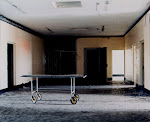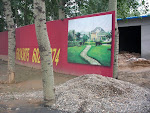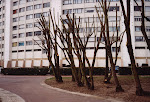Monday, July 7, 2008
Extract from Rachel Andrews essay on the Maze Project-work in progress-July 2008
The topography of demolition.
After the grey and the shush of the silence, the first thing you notice is the rabbits. Or, at least, the sense of their presence. A tail disappearing behind a bush. A frantic scatter at the edge of your vision. Often, you see only the traces. Droppings to the side of the sports areas, or in the thick, damp moss that grows along by the barbed wire and the high walls. All the time, though, you know they are there. Along – you hear later - with the wildcats and the buzzards. And the flowers. The wild gorse and foxgloves and nettles. Nature beginning the reclaim of its own.
You admire the confidence - the sheer entitlement - of the encroaching wildlife, to its place in this space of dominance and containment. This is the terrain of men, carved out of rules and regime. It is a place of signs and warnings. ‘STOP, HOLD, LOCK.’ ‘Switch off engine when parked in airlock.’ Of pictures – guard dogs and prison officers. ‘CAUTION, we patrol the area.’ It is no place for the soft scatter of a furry bunny.
We first come to the Maze on the bright of a blustery summer afternoon, expecting, not rabbits, but the whispers of history. The approach of the landscape, the loom of its watchtowers a silent insult against the bustling grey-blue of the sky, suggests the story of these memories. We have seen these towers before, framed in front of us on our television screens, in the days when the North and all its troubles formed a blurry backdrop to our growing lives. We know what they have to say. Inside, we are certain, the buildings will speak. They will tell us: “Here died Bobby Sands.” “Here, the prisoners escaped.” “Here Billy Wright was shot.”
We know the story already. Emotion. Echoes. Superlatives. All we have to do is observe it, and write it down. Here and here and here.
***
I saw where Bobby Sands died, there in the corner of a hospital cell. I stood in the corridor and stared in, imagining. For a moment, some kind of feeling flickered, then went out. Now, all I remember is the blankness. That, and the cold of the colours, grey and green and yellow.
***
The Maze had a story to tell me allright, but it was not the story I had come to hear. It was a story of concrete, solid, reinforced. Of razor wire, scrambling sixteen feet upwards, ten across. Of steel, shutting behind me in a doorway. It was a story of the brutal shape and structure of a building constructed cheap and fast, in half the usual time it took to build a prison, a hasty solution to controlling an out of control problem. It was a story, surely, of numbed, interrupted humanity, because no humanity could ever have been expected here.
Now the story is changing again. All day, the hit and the spike and the crack of the digger reduces it, breaks it apart. From block to slow block, the JCBs trundle, focused, relentless, long arm extended. Buildings converted to bodily parts. By the time I arrive at the prison, seven months into the demolition process, six H-Blocks are gone. Next time I come to the Maze I will see only a no man’s land. Or a no place. And what does a no place have to say?
We are unfamiliar newcomers, and we take the long way round. Left off the Dublin Road, following the sign for Maze-Moira. Right up Trench Road, towards the Down Royal Racecourse. Over the humped back bridge into Mazetown. Red-bricked houses, small, neat, in rows; later they come larger, detached, retreated into middle-class developments. Churches: Methodist, Presbyterian, a Masonic Lodge, an Orange Hall. Flags, in doorways, from entrance gates. The flag of St George. The Union Jack.
Through Mazetown. Past the bigger, newer estates, all glistening sports cars and SUVs. Past the famous Down Royal: ‘Home of the Northern Ireland Festival of Racing’, and the pub, Gowdy’s at The Racecourse. Round one corner, then another. Swing right onto Bog Road, twisting, winding. Notice the signs, out the backs of the alongside houses. For Sale: Tvs, Hi-Fis, Cars. Nursery schools. After School Activities. Small initiatives, but the beginnings of a nudging identity change for this area, and the others, that have been defined by their position in the shadow of the Maze, onto which their gardens back, and where their people went to work - as joiners, kitchen staff, prison officers - over 30 years.
On down Bog Road, towards the crossroads. After a while, the houses thin out, then disappear, and then are replaced, by a line of wire fencing , the first ominous sign, and then the fence changes into the grey, corrugated blockage of the outer visitor’s gate, overgrown and sprawling, a floodlight peering down, and then the road goes on and we take another turn, and then, on our right: a concrete wall, a sentry post, flags fluttering, barbed wire. The main entrance gate, wire steel, a kind of cage. And signs. Maze Regeneration Site, Reinvestment and Reform Initiative. DANGER. Demolition in Progress. KEEP OUT.
Keep Out. Time was, visitors went only slowly inside the Maze; the women waiting in the cold and the worry to see their menfolk, not knowing would they be allowed in today, tonight, tomorrow, lips set tight with fear for their children left behind on their own. It took hours to get in and the same to get out, through all the checks and double checks and the monitoring. But in the half-space of time and inactivity between closure and demolishment, the prison opened its gates, not freely, still cautious, and the visitors came quick and curious: the residents, from neighbouring village Halftown, photos on their walls as bemused proof, the archaelogists, the photographers, the artists, the school tours. Former prisoners, back and forth, analysing, discussing the future. One time, just like that, we almost run into Bik McFarlane, the name, of course, notorious to us. The ones who broke out now strolling back in.
We drive up, car nose nudging against the gate, and a man saunters out to greet us. For the moment, we are welcome, permission granted through the ponderous structures of the fledgling Northern bureaucracy, which will later, in the way of such bureaucracies, make a sudden, swift decision to pull us out. The man drags open the gateway, and we are inside.
I stand out of the car, my back to the entrance, and an openness spreads out in front of me. The Maze complex is 360 acres, two and a half miles long, a distance which, when it comes all together, is hard to process. I try to make sense of the windswept bleakness, reminded of another, urban environment: the dwarfing apartment blocks and wide streets of post-Communist Berlin, the last place I felt so strongly and uneasily the blank indifference and oppression of my surroundings. I look at the security hut on my left and the men waving out at us. Later we will join them for tea and biscuits, but for now we say our hellos and push on, our time organised, limited. I look at the bricked Toilet hut on my right. Further on, there is another hut, large and sickly green, with a great pushdown entrance. The old car processing site, where vehicles were assessed and inspected.
And after that, all I see is wasteland. Mounds of ordered rubble, in their high, separate bundles, of wood and steel and concrete. Flattened, bent-over grass, the outline of a building still traced on top of it. A lone twig tree growing up and out of a crunching expanse of gravel and stones. Further again, there is the inside prison wall, half in pieces, cut short in its snaking journey around and through. It’s not hard to describe this place. We all reach for the same metaphor. Like a bomb site. It looks just like a bomb site now.
We walk. The Maze is not for the walker. Prisoners and visitors alike were driven in windowless vans, deliberately disorientating, across the long space from one H Block to another, from workshop to visiting block and back again. But I need to get my own sense of this disappearing place where everything looks the same. The watchtowers stare down at us, aloof and unmoved, as we turn one way, then the next. In a while, we will go into the Maze Cellular, where the H-Blocks are, but first, we climb, through a jungle of gorse and trees, over mossy ground, into Long Kesh, the beginning of it all, where the young and not so young went when internment got the go ahead, and the men were taken in off the streets.
Long Kesh was left for dead long ago, after the H Blocks were built and the prisoners moved on. On a January morning, months after my first summer visit, the compound lies silent and empty in the piercing cold, its slumber broken only by the occasional panicked rattle of a passing bird, or the just discernible swhoosh of the cars on the nearby motorway. The Nissen huts, what’s left of them – for they are also being demolished – are unreachable, encased by looping, snarled barbed wire, and shrouded by the steadily advancing wilderness. But they don’t take much imagining. Low, rounded rooves of corrugated iron set on a black bricked base. A wooden door, swinging and jagged. Here, they crammed the men in, 40 to a hut. Shoved, one on top of the other in bunk beds, colder inside than out, freezing by day, freezing all night. Like for animals. I write it down. A concentration camp, for all the world.
Except for the nature, Long Kesh is all black. Once inside the Maze, we see colours. Searing turquoise. Deep, dull red. Pink traces on grey. You come upon them suddenly, a strange surprise. They grab you because they are unexpected, and somehow that makes it all the more unsettling. There is no comfort in the sign, red on white, at the Visitor’s Centre: DANGER. Or in the splash of sunny yellow at the doorway: NO PERSON SHOULD PASS THE YELLOW LINE WHILE GATE IS IN MOTION. Inside, the pale pastel pink of the walls and tables hints at a false cheery, holiday-camp atmosphere, but the blue chairs, crushed three, four deep up against each other, reminds you that the encounter, across a table, between husband and wife, mother and son, was a controlled one. Half an hour, an hour, of eyes up, eyes down, hand-holding, crying, laughing, always aware of the presence at your back, at your front. Time’s up now. Move on.
Worst of all are the baby chairs. Eight of them in a small, separate room. Glaring yellow against the faded walls and floors. Scattered around tiny tables, themselves an upturned blue and white. Fairground colours, all smiles and waves, trying to rectify the unrectifiable. Like the flowers and berries in the prisoners’ gardens, or the carefully chalk-drawn goalposts in the sports areas, the chairs are all wrong. They are close-your-eyes pathetic. I am a new mother, and I find I cannot bear that children knew this closed-in place. The sins of the fathers, tumbling down on the heads of the babes below.
Subscribe to:
Posts (Atom)























